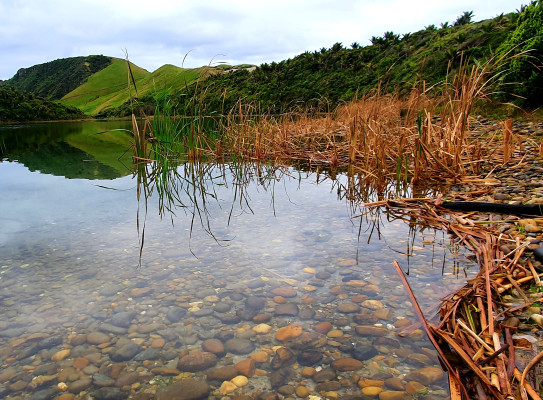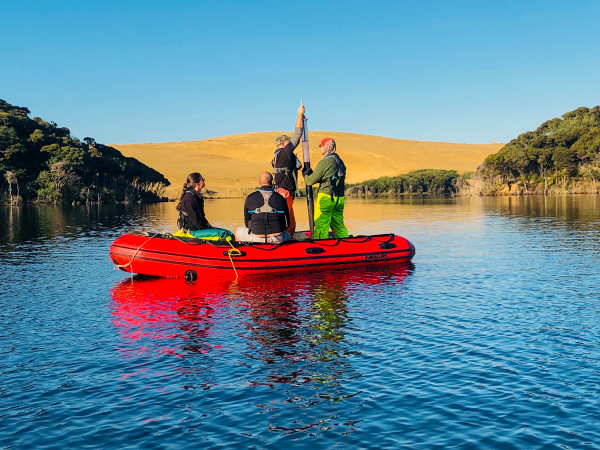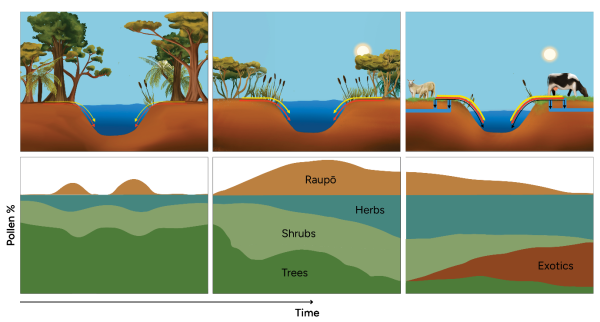Raupō pollen records reveal link with Māori settlement, and potential for lake restoration

New research has reconstructed a 1000-year history of the iconic native wetland plant raupō – also known as bulrush. Pollen hidden in lake sediment shows that raupō flourished in Aotearoa New Zealand following human arrival, suggesting a rich association between Māori and raupō.
Raupō (Typha orientalis) is common in coastal and lowland fertile wetlands, and on the margins of ponds, lakes, slow-flowing streams, and rivers in the North and South Islands and on Raoul Island. Although native, it is sometimes considered invasive. However, research from the GNS Science and Cawthron Institute co-led research programme Lakes380 indicates that the ability of raupō to rapidly colonise new locations provides it with a potential role to trap nutrients, restore wetlands and enhance freshwater quality.
The team analysed sediment core records from 92 lakes and found that raupō has thrived in past times of environmental disturbance, such as storms, floods, volcanic ashfall and human modification of the landscape.
"When this disturbance led to deforestation at lake edges, and slips and flooding delivered nutrient-rich sediment, raupō would increase," says Xun Li, the study’s lead author and Palynologist at GNS Science.
"As a wetland plant, raupō needs both submerged roots and light to grow. Before settlement, when dense forest covered most of the country, raupō was waiting on the fringes, seizing the opportunities created by these disruptive events to thrive," says Rewi Newnham, study co-author and Professor in Physical Geography at Te Herenga Waka – Victoria University of Wellington.

Prior to human arrival the environmental disturbances, and the localised flourishing of raupō, were short-lived. Following Māori arrival, forest modification and wildfires became more persistent in some regions, with an increase in sediment flux into lakes.
The study found that the abundance of raupō pollen increased post-Māori arrival in Aotearoa at 87% of the sites analysed, with the maximum expansion taking place during Māori settlement. Then followed a subsequent decline during European settlement – the most obvious cause being widespread draining of wetlands and management of lakes to promote intensified agriculture.

Historical and archaeological records, alongside mātauranga Māori knowledge, describe the wide variety of important uses pre-European Māori developed for raupō – the leaves were woven into mats and rope and used to make poi, leaves and stems served as thatch for whare roofs and walls, and various parts of the plant were eaten. Raupō is now recognised as a taonga species.
Li says that the evidence from the lake sediment cores is sufficient to consider raupō a "human associate" species.
"The pollen records show a very clear connection between Māori settlement and the expansion of raupō, indicating that raupō was promoted indirectly by the rapid spread of early Māori settlers throughout most of Aotearoa."
It’s possible that raupō was intentionally introduced to new areas, due to its value as a material and food resource. Some of the records support this.
By intercepting sediment and nutrient flux at the banks of lakes, raupō may serve as a buffer to potential contamination of a lake ecosystem.
“Preliminary results, such as changes in the agal species in the sediment records, indicate that this may have been the case at some of the study sites. Our paleoecological observations from the past suggest raupō could have a role to play in managed wetland recovery today,” says Newnham.
-
Lakes380 and Our Lakes, Our Future
- Insights into the natural and cultural history of Typha orientalis (Raupō) in Aotearoa New Zealand (external link)was published in the PLOS Water scientific journal. The research was funded by the Ministry of Business, Innovation and Employment through the research programmes Lakes380 and Our Lakes, Our Future.
- Lakes380: Our lakes’ health past, present, future(external link) was a five-year research programme co-led by GNS Science and Cawthron Institute and was the biggest scientific study of Aotearoa’s lakes ever undertaken. Researchers sampled 10% of our lakes and found that 45% are in poor or worse condition.
- Our Lakes, Our Future: enhancing lake health in Aotearoa(external link) is a new research programme that is building on the work of Lakes380 to develop holistic approaches for characterising lake health, assessing their vulnerability to degradation and climate change, and enhancing lake restoration.